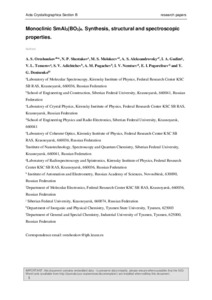Monoclinic SmAl3(BO3)4: synthesis, structural and spectroscopic properties
Скачать файл:
URI (для ссылок/цитирований):
http://scripts.iucr.org/cgi-bin/paper?S2052520620008781https://elib.sfu-kras.ru/handle/2311/142968
Автор:
Oreshonkov, A. S.
Shestakov, N. P.
Molokeev, M. S.
Aleksandrovsky, A. S.
Gudim, I. A.
Temerov, V. L.
Adichtchev, S. V.
Pugachev, A. M.
Nemtsev, I. V.
Pogoreltsev, E. I.
Denisenko, Y. G.
Коллективный автор:
Инженерно-строительный институт
Институт инженерной физики и радиоэлектроники
Кафедра проектирования зданий и экспертизы недвижимости
Базовая кафедра физики твердого тела и нанотехнологий
Дата:
2020-08Журнал:
Acta Crystallographica Section B: Structural Science, Crystal Engineering and MaterialsКвартиль журнала в Scopus:
Q1Квартиль журнала в Web of Science:
Q3Библиографическое описание:
Oreshonkov, A. S. Monoclinic SmAl3(BO3)4: synthesis, structural and spectroscopic properties [Текст] / A. S. Oreshonkov, N. P. Shestakov, M. S. Molokeev, A. S. Aleksandrovsky, I. A. Gudim, V. L. Temerov, S. V. Adichtchev, A. M. Pugachev, I. V. Nemtsev, E. I. Pogoreltsev, Y. G. Denisenko // Acta Crystallographica Section B: Structural Science, Crystal Engineering and Materials. — 2020. — Т. 76 (ч.4). — С. 654-660Текст статьи не публикуется в открытом доступе в соответствии с политикой журнала.
Аннотация:
The SmAl3(BO3)4 single crystals are synthesized by the group growth on seeds method, and its crystal structure was solved from single crystal experiment and purity of the bulk material was proved by Rietveld method. This borate crystallizes in the monoclinic space group C2/c with cell parameters a = 7.2386 (3) Å, b = 9.3412 (5) Å, c = 11.1013 (4) Å, β = 103.2240 (10) °. The Infrared and Raman spectroscopy confirmed the monoclinic structure of SmAl3(BO3)4. Under the 532.1 nm excitation, luminescence spectra exhibit bands assignable to the transitions from 4G5/2 to 6H5/2, 6H7/2, 6H9/2 and 6H11/2. Similarity of luminescence spectra of trigonal and monoclinic polymorphs is explained by the minor role of Sm-O bond distortion and primary role of rotation distortion of SmO6 octahedra. Smaller covalency of Sm-O bond in alumoborates is deduced in comparison with galloborates. Calorimetric measurements did not reveal high-temperature structural phase transitions up to 720 K.

